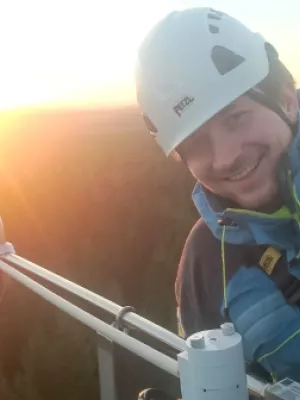
Michal Heliasz
Research engineer

A dedicated flask sampling strategy developed for Integrated Carbon Observation System (ICOS) stations based on CO2 and CO measurements and Stochastic Time-Inverted Lagrangian Transport (STILT) footprint modelling
Author
Summary, in English
In situ CO2 and CO measurements from five Integrated Carbon Observation System (ICOS) atmosphere stations have been analysed together with footprint model runs from the regional Stochastic Time-Inverted Lagrangian Transport (STILT) model to develop a dedicated strategy for flask sampling with an automated sampler. Flask sampling in ICOS has three different purposes, namely (1) to provide an independent quality control for in situ observations, (2) to provide representative information on atmospheric components currently not monitored in situ at the stations, and (3) to collect samples for 14CO2 analysis that are significantly influenced by fossil fuel CO2 ( ffCO2 ) emission areas. Based on the existing data and experimental results obtained at the Heidelberg pilot station with a prototype flask sampler, we suggest that single flask samples are collected regularly every third day around noon or in the afternoon from the highest level of a tower station. Air samples shall be collected over 1 h, with equal temporal weighting, to obtain a true hourly mean. At all stations studied, more than 50 % of flasks collected around midday will likely be sampled during low ambient variability ( <0.5 parts per million (ppm) standard deviation of 1 min values). Based on a first application at the Hohenpeißenberg ICOS site, such flask data are principally suitable for detecting CO2 concentration biases larger than 0.1 ppm with a 1 σ confidence level between flask and in situ observations from only five flask comparisons. In order to have a maximum chance to also sample ffCO2 emission areas, additional flasks are collected on all other days in the afternoon. To check if the ffCO2 component will indeed be large in these samples, we use the continuous in situ CO observations. The CO deviation from an estimated background value is determined the day after each flask sampling, and depending on this offset, an automated decision is made as to whether a flask shall be retained for 14CO2 analysis. It turned out that, based on existing data, ffCO2 events of more than 4-5 ppm that would allow ffCO2 estimates with an uncertainty below 30 % were very rare at all stations studied, particularly in summer (only zero to five events per month<span idCombining double low line"page11162"/> from May to August). During the other seasons, events could be collected more frequently. The strategy developed in this project is currently being implemented at the ICOS stations.
Department/s
- eSSENCE: The e-Science Collaboration
- ICOS Sweden
- Centre for Environmental and Climate Science (CEC)
Publishing year
2020
Language
English
Pages
11161-11180
Publication/Series
Atmospheric Chemistry and Physics
Volume
20
Issue
18
Document type
Journal article
Publisher
Copernicus GmbH
Topic
- Meteorology and Atmospheric Sciences
- Climate Research
Status
Published
ISBN/ISSN/Other
- ISSN: 1680-7316